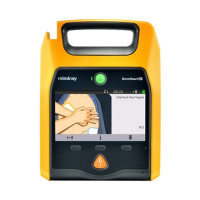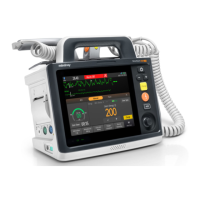Defibrillator/Monitor Operator’s Manual 7 - 3
7.4 Manual Defibrillation Procedure
1. Remove clothing from the patient’s chest. Wipe moisture from the patient’s chest and, if necessary, clip or
shave excessive chest hair.
2. Plug the therapy cable into the therapy port. Push until you hear it clicks into place.
3. Prepare the patient and apply the electrode pads/external paddles.
◆ If electrode pads are used, apply electrode pads to the patient as described in 5.4.3ECG
MonitoringMeasurement with Paddles/Electrode Pads.
◆ If external paddles are used, remove the paddle set from the paddle tray by grasping the handles and
pulling them straight up. Apply conductive gel to the electrode surface of each paddle. Place the
external paddles as described in 5.4.4ECG Measurement with External Paddles.
• Hold only the insulating parts of the paddle handles to avoid shock hazard during charging or shock
delivery.
Switch the Mode Select knob to Manual Defib. You can define [Manual Therapy Access] by selecting
[Manual Defib Setup] from the Configuration Main menu.
4. Select energy
You can use the Navigation knob to switch the patient category between [Adu], [Ped] and [Neo], if
necessary. The default energy level is automatically changed.
◆ For defibrillation of adult patients, recommended energy level for the first shock is 200 J.
◆ For defibrillation of pediatric patients, recommended energy level for the first shock is 50 J.
(5) Selected energy
(6)
S
hock counter
(7) Auxiliary parameter and/or waveform area:
This area displays parameters from SpO
2
, NIBP or CO
2.
You can define the auxiliary
parameter by selecting [Manual Defib Setup] from the Configuration Main menu.
Do not touch this surface and the part below.

